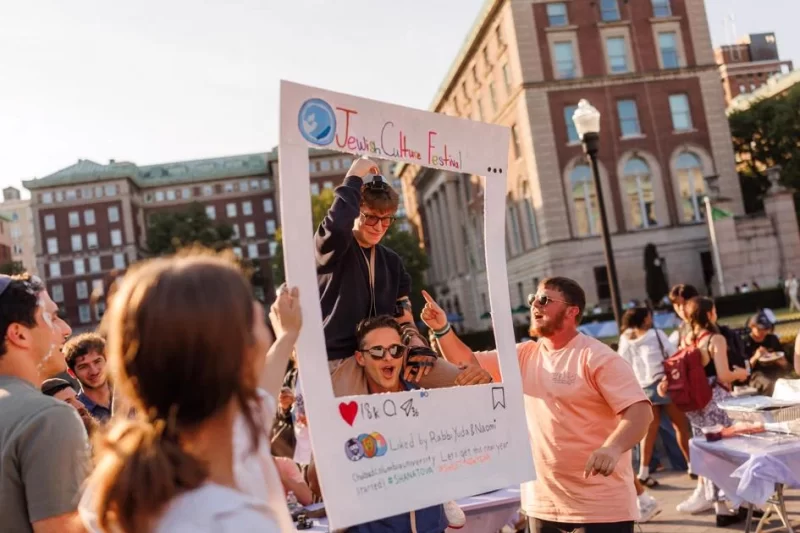
Unhiding Jewish Pride on Columbia University’s Lawn
by Moshe New – chabad.org
When Rabbi Yuda and Naomi Drizin, co-directors of Chabad-Lubavitch at Columbia University, sought to welcome students back to campus this year, they envisioned something uniquely Jewish, large-scale, and above all, fun.
“Together with our Chabad student leaders, we wanted to create a warm, joyful celebration with positive energy,” Rabbi Drizin explains. “A Jewish Culture Festival seemed the perfect way to be welcoming and genial.”
The event drew more than 2,000 attendees, including students, faculty and administrators. Drizin notes that many non-Jewish participants came, either accompanying Jewish friends or out of genuine interest to learn about Jewish traditions.
Rachel Kaufmann, a sophomore at Barnard College majoring in art history and economics, shared her enthusiasm for what she calls “a major success.”
“I was really excited when I heard about the event,” she told Chabad.org. “There was a fun and lighthearted atmosphere. While some people were a bit nervous given recent events, I was genuinely looking forward to it. We didn’t anticipate just how successful it would be.”
‘A Full Circle Moment’
Senior members of the administration of both Columbia University and Barnard College attended the event. “We are thankful to the administration for being so helpful, along with the public safety office, Office of Religious Life and event management,” said the rabbi. “Their cooperation ensured that our event was able to go off without a hitch.”
Jessica Yeroshalmi, a second-year student at Columbia Law School, shared that for her, the festival last week was a healing experience.
“Having the event at Butler Plaza was cathartic. It was a full-circle moment,” she said. “This was the scene of the heinous antisemitism that we saw last semester. To be able to celebrate our Judaism now, safely as Jews, was so freeing. It was a stark contrast to last semester, when we were so shaken up.”
Yeroshalmi said that “things on campus were really bad” in the immediate aftermath of Oct. 7. And that wasn’t the end of it. “In the months afterwards, it just got worse and worse until coming to a head,” she explained, referring to antisemitic incidents targeting Jewish students at Columbia University. The situation escalated at the end of April, when anti-Israel protesters openly attacked Jewish students. It was only after masked demonstrators took over an administration building that police were summoned, leading to 100-plus arrests. Columbia has since faced heavy scrutiny for its failure to protect its Jewish students.

According to Yeroshalmi, it is the leadership of Jewish leaders like Drizin that open the door for positivity. “We are so grateful to have Jewish communal leaders who think of doing things like this, and who are always in our corner,” she said.
And now, thanks to Chabad, instead of uncertainty and fear being the welcome mat to Jewish students this semester, it was Jewish pride that ushered them in.
Kaufmann, who has been involved with Chabad at Columbia since her freshman year, ran one of the festival’s popular attractions.
“I managed the ‘Oy Vey’ booth, where we offered traditional foods that people often hesitate to try—like herring, gefilte fish and liver—alongside more familiar dishes such as potato kugel. Visitors would spin a wheel to determine which food they’d taste,” she said.
The humorously named booths—another, pie-themed one was called “Am Yisrael Pie”—turned out to be a hit. “Surprisingly, many non-Jewish visitors came back for more gefilte fish,” Kaufmann noted with a laugh.
She also highlighted the educational aspect of the experience. “There was genuine curiosity about our cuisine. People asked when we eat certain dishes, what they’re called and which holidays they’re associated with. It was a great opportunity to dispel any myths and share the beauty of our heritage.”
“At the smallest level, they were learning who we are. The event was lighthearted and made Judaism approachable,” Yeroshalmi concurred.
‘Truly Remarkable’
The festival featured various booths highlighting unique aspects of Jewish heritage. Participants could decorate Judaic items, like mezuzahs and tefillin bags, make Havdalah candles and engage in other cultural activities.
“The atmosphere was truly remarkable,” says Drizin. “Smiling, peaceful faces everywhere. It was a celebration of the richness and diversity of our heritage.”
Cloe Federici, an Italian-born junior in the Columbia School of General Studies completing a double major in political science and Middle Eastern studies, shared her perspective as a newcomer to New York, having arrived less than a month ago.
As part of an exchange program with Tel Aviv University, she says that some of her friends in Israel who had originally planned to join her in New York chose to drop out of the program in favor of other exchange opportunities.
“On one hand, we didn’t want to miss out on the opportunities we knew we deserved as much as anyone else,” she said. “On the other, we were scared about what we were hearing.”
Fast-forward a few months, and Cloe was standing on Butler Lawn, staffing a booth that showcased various foods both from Sephardic and Ashkenazic heritages. Cloe, who comes from an Italian family of Sephardic Jews was in charge of the Sephardic side.
“The most successful foods were rugelach for the Ashkenazi side and kibbeh for Sephardi,” Federici observed. We finished the food so quickly because everyone was so amazed by how good it was. In 14 minutes, everything was gone.”
She added that “there was no hatred. This was the first time for me since Oct. 7, where I could be free to be me and proud to be Jewish.”
That liberating feeling of Jewish pride was evident across the course of the event. Jewish music blared from speakers, Drizin and a team of volunteers helped hundreds of men don tefillin, and distributed a similar number of Shabbat candles to women. There was even an impromptu bar mitzvah ceremony for a participant who had never wrapped tefillin before, complete with dancing and singing.
But according to Federici, the story hasn’t ended: “We can’t be naive. Expressing our culture in this universal language, we made a step forward in shifting the dialogue.”
As such, she is looking forward to the next stage of her chapter: “This festival changed the game for me. It makes me have such a positive outlook on the opportunities I have this year, and confidence to meet people and tell my story.”
For Yeroshalmi, this event kickstarted the new school year with a different tone to the last. “By starting this year like this, we have an opportunity to set the tone for the upcoming year. G‑d willing, we’re starting on a different foot.”
When asked who gained the most out of the event, her reply was simple: “Everyone needed this. Jews, non-Jews—the world needed this.”














